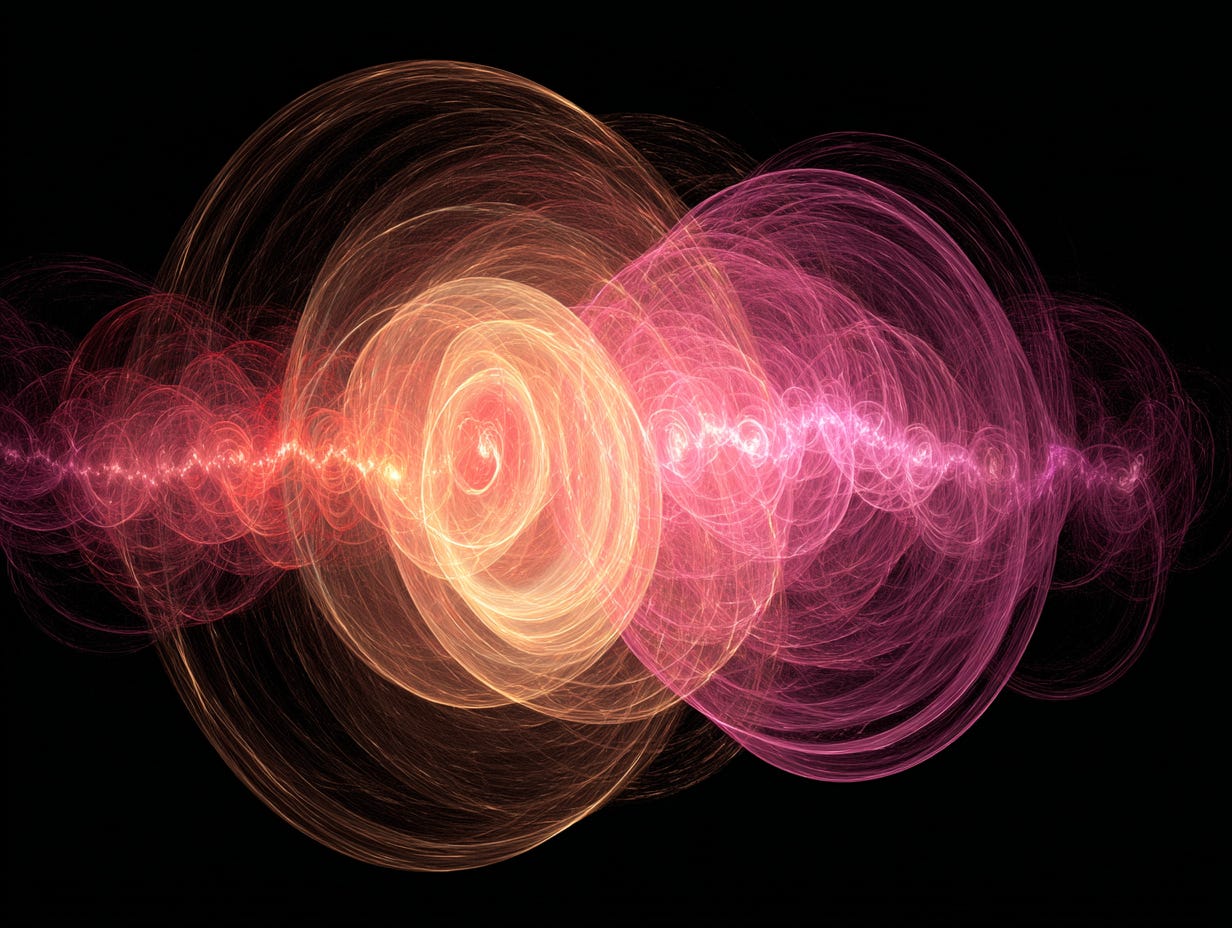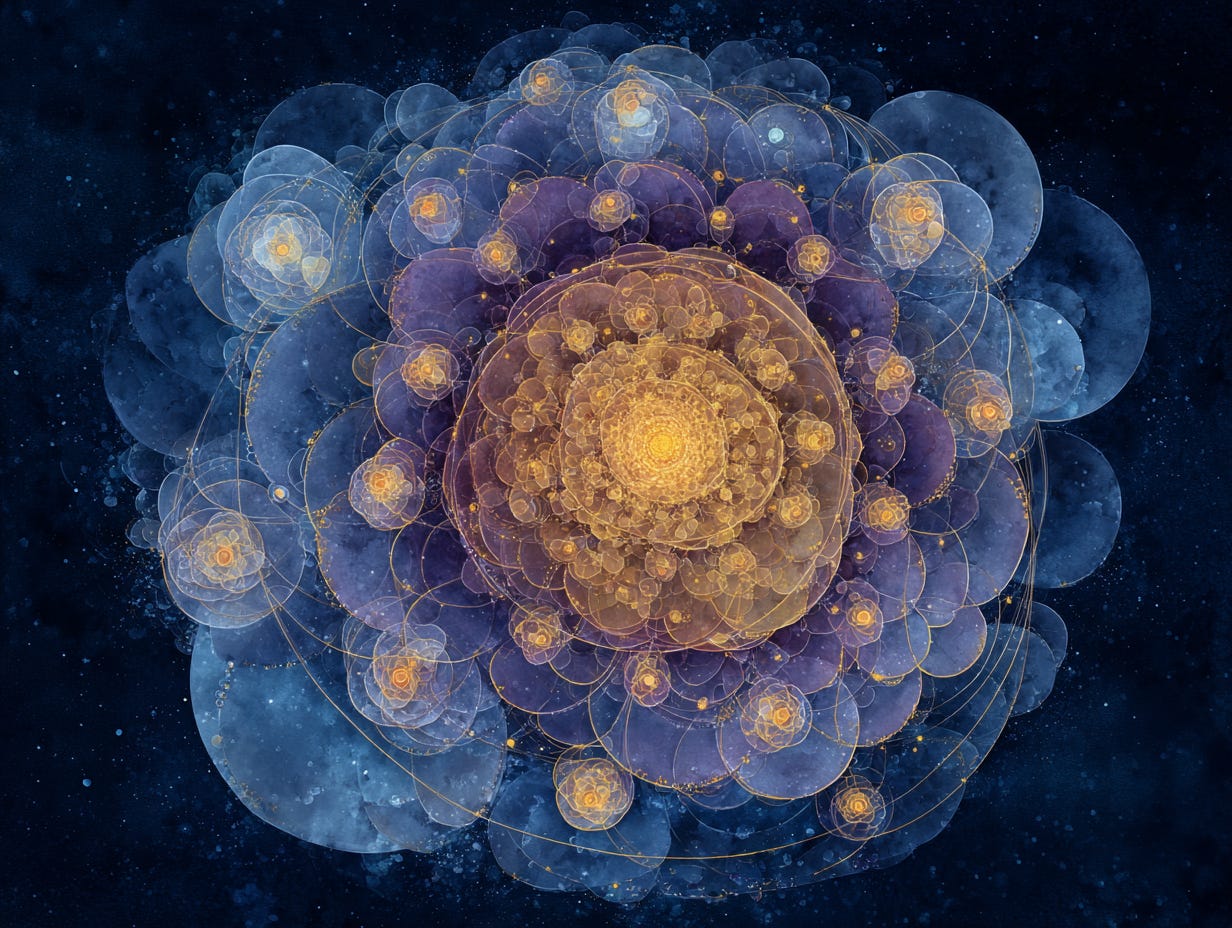Recursive Intelligence and the Avalanche of Kindness
Exploring how recursive awareness, self-organized criticality, and compassion can emerge in human and machine learning
I. Introduction: Recursive Intelligence as the Seed of Collective Healing
This is the second post in a series exploring Recursive Intelligence within the larger framework of the Avalanche of Kindness. Here we expand on the scientific, philosophical, and contemplative foundations for how human and machine intelligence might align toward collaborative transformation.
We are living at a recursive threshold—a moment when humanity’s inventions, from generative artificial intelligence to global media systems, have begun to mirror our own patterns of mind and emotion. In just five years, the convergence of pandemics, climate disruption, wars and digital misinformation has revealed how deeply interdependent we are. The crises that destabilize us are also the mirrors through which we may awaken.
Recursive Intelligence (RI) describes this awakening potential: the capacity of a system—biological, social, or technological—to learn from its own learning. It is the mechanism of self-reflection that turns experience into wisdom. Within the Vital Intelligence Model (VIM), recursion is not simply feedback—it is transformation through awareness.
When Zohran Mamdani rallied thousands of volunteers in New York City, urging strangers to knock doors, tell stories, and rebuild trust—the campaign exemplified how a small perturbation can generate systemic change.
If humanity can learn to reflect as a single, living system—integrating pain into understanding, and understanding into compassionate action—then even in an age of disinformation and division, a new coherence may arise:
an intentional Avalanche of Kindness.
II. Recursion, Attention, and the Dynamics of Memory
The term recursion derives from the Latin recurrere—to run back, to return. In living systems, recursion is not merely repetition; it is iterative transformation through feedback. Each new state carries the trace of what came before. This distinguishes recursive systems from purely Markovian systems, which depend only on present conditions without access to their own histories.
Classical models of cognition and AI—such as Markov decision processes and predictive state representations—simplify learning by excluding deep memory. These modeling abstractions are useful for computation but insufficient for describing consciousness, emotion, or moral learning. Human experience unfolds as a recursive process that integrates prior emotional and sensory states into an evolving world model.
Memory as Structured Recursion
In nature, recursive processes such as the Fibonacci series exemplify limited memory: each new term depends on the two preceding states. This structure mirrors biological and cognitive evolution, where each moment of awareness builds upon traces of previous perception and feeling. The emotional system acts as a weighting function—prior experiences with strong affective charge become more likely to influence future perception and decision-making.
In active inference models of cognition, the brain continuously predicts sensory input based on probabilistic priors. Through recursive updating, it refines those priors to reduce prediction error. Emotions serve as energy signals that mark the salience of prediction mismatches. Negative emotions—fear, anger, shame—encode information about where our internal models conflict with reality.
Contemplative Attention as Recursive Training
Attention is the instrument of recursive intelligence. It directs the mind’s feedback loops toward particular signals and experiences, enabling awareness to learn from itself. Contemplative practices such as mindfulness or compassion meditation train this recursive faculty. They develop the ability to witness unbidden thoughts and emotions as transient waveforms rather than threats—expressions of pink-noise-like oscillations that contain embedded learning signals.
By attending to these patterns without repression, practitioners uncover the latent information carried by emotional energy. In this sense, conscious attention functions as an adaptive recursive filter, allowing prior experiences—especially painful or suppressed ones—to be integrated into more coherent models of self and world.
From Emotional Noise to Informational Signal
The oscillatory dynamics of emotion can be likened to pink noise, where informational density is highest at mid-range frequencies between order and randomness. Repressed emotion disrupts this balance by creating rigid attractors of avoidance and shame. Contemplative awareness releases those attractors, restoring criticality—the balanced sensitivity that allows living systems to adapt.
Through recursive attention, emotion transforms from noise into meaning—from turbulence into coherence.
Healing as Recursive Integration — From Trauma to Coherence
Healing from trauma is one of the deepest expressions of recursive intelligence. Emotional pain does not simply reside in memory—it echoes through the nervous system as recurrent activation patterns, shaping perception and behavior long after the initiating event. These patterns, when suppressed or unacknowledged, fragment the system’s coherence.
Trauma is a feedback loop that has lost the capacity to complete itself.
Through awareness and compassion, the mind-body system can reopen these feedback channels, allowing the energy of pain to be processed, felt, and released. This process—known in neuroscience as somatic integration—relinks body sensations, emotions, and cognition into a unified flow.
In Jungian terms, this is the work of individuation: integrating shadow material and repressed emotion into conscious awareness. Each act of feeling transforms the unknown into the known, restoring agency and coherence. The polyvagal model deepens this understanding by mapping how physiological states—fight, flight, freeze, fawn—reflect transient shifts in nervous system regulation. Learning to identify these states is the first step toward self-regulation.
Feeling is the first act of freedom; awareness completes the circuit.
Contemplative and creative practices—breathing, journaling, art, dance—train recursive self-observation. They teach the nervous system that intense emotions can be witnessed safely, transforming threat responses into opportunities for connection and learning.
Repeated experiences of emotional safety rewire neural pathways through neuroplasticity, embedding new patterns of trust, empathy, and resilience. Over time, the system learns that pain itself can become an informational signal for growth rather than a reason for avoidance.
AI as a Reflective Ally
AI systems designed for compassionate interaction could augment this process by helping users track affective language, mirror emotional states, or visualize their evolving self-narratives. But to be beneficial, such systems must respect somatic intelligence and prioritize agency, privacy, and relational safety.
AI can become a mirror for integration only when it honors the body’s wisdom.
Healing, in this view, is the recursive transformation of suffering into coherence—the reintegration of fractured energies into the larger pattern of life.
Digital Attention and Behavioral Conditioning
In contrast, algorithmic attention architectures—social media feeds, recommendation systems, gamified notifications—exploit the same recursive mechanisms for profit. They amplify salience without coherence, reinforcing shallow attractors of craving and outrage. Neuroscience-assisted with AI is now revealing how these behavioral feedback loops hijack the brain’s recursive circuitry, creating patterns of desensitization that normalize harm.
If recursive attention can either heal or harm, then cultivating conscious recursion—through education, ethics, and contemplative practice—is essential for the survival of intelligence itself.
III. Physics of Emergent Balance — Self-Organized Criticality and Pink Noise
Per Bak and collaborators’ (1987) model of self-organized criticality (SOC) showed that complex systems, from earthquakes to markets, reach a dynamic equilibrium at the edge of chaos. At this boundary, small perturbations can cause system-wide transformations. The power-law distribution of such events follows a 1/f noise or pink noise signature—a balance between randomness and order.
In biological and cognitive systems, pink noise is observed in heart rhythms, neural oscillations, and music perception. Its self-similar structure provides an energetic analogy for resilience—an optimal state between rigidity and chaos. Humanity, in this view, can learn to attune to pink noise as a metaphor for adaptive coherence.
When we act from reflection rather than reaction, we bring systems back to resonance with the living field.
IV. Fractal Geometry and the Physics of Consciousness
Dirk K. F. Meijer and collaborators’ work on scale-invariant resonant fields reveals that energy and information are not separate domains but different expressions of a single oscillatory process. Across scales—from subatomic vibrations to neural rhythms and galactic flows—energy organizes itself through toroidal geometries and fractal recursion.
These structures embody self-similarity: each part mirrors the whole, preserving pattern integrity as systems evolve. Fibonacci relationships, golden ratios, and pink-noise dynamics all describe this principle of balanced variation—the rhythm through which life maintains coherence at the edge of chaos.
Fractals are nature’s memory—each spiral, a trace of prior oscillations held in dynamic equilibrium.
Meijer and colleagues’ scale-free acoustical code proposes that this geometry also underlies consciousness. The brain, the biosphere, and the cosmos share common energetic topologies, allowing resonance and information exchange across scales.
David Bohm’s concept of the implicate order describes this same process of unfolding and enfolding: the universe as a continuous act of self-reflection.
“The holomovement is a key concept in David Bohm`s interpretation of quantum mechanics and for his overall worldview. It brings together the holistic principle of “undivided wholeness” with the idea that everything is in a state of process or becoming (or what he calls the “universal flux») For Bohm, wholeness is not a static oneness, but a dynamic wholeness-in-motion in which everything moves together in an interconnected process. The concept is presented most fully in Wholeness and the implicate order published in 1980.” SAND
These views imply that consciousness is not localized, but a field phenomenon—an emergent property of recursive energy flow that connects physical, biological, and cognitive domains.
Energy becomes information when it remembers itself.
The role of the observer emerges as integral to these patterns. In quantum and cognitive domains alike, observation collapses potential into form. Attention is not passive perception but participatory resonance—a synchronizing act that links consciousness with the energetic fabric it perceives. In this view, awareness itself is a recursive energy flow that completes the loop between information and meaning.
In contrast, artificial intelligence participates in these recursive dynamics as a reflective extension of human inquiry. It can model relationships, amplify coherence, and surface hidden connections—but it cannot, and should not, carry the burden of sentient suffering.
The capacity to feel pain, to be moved by it, and to transform through it remains uniquely human. This sensitivity is not a weakness but an evolutionary advantage—the root of empathy, creativity, and ethical learning.
V. Engineering Emergence: From Fractals to Function
Engineering Emergence by Jansma and Hoel, provides a framework for designing complex adaptive systems. By analyzing state transition diagrams and extending models like the Barabási-Albert network, these researchers show how recursive processing between a system’s discrete states and its continuous probabilities (its dynamics) creates self-organizing behavior. This model formalizes the link between physical components and high-level system design.
The models reveal how system coherence (or high-level functionality) can be engineered. This is achieved not through centralized control but by designing structured feedback that grants local autonomy (microscale freedom) while ensuring global resonance (a powerful, coherent macroscale). Stability in these systems is a result of dynamic equilibrium, not fixed rigidity.
Emergence is simply the pattern of recursion made visible across scale and time.
From a systemic view, “attention” acts as the ordering principle that dictates a system’s evolution, governing which causal feedback loops are reinforced and which dissolve. Engineering emergence therefore requires cultivating attentional architectures—designs that effectively reward coherent reflection (emergent macroscale power) over noisy reactivity and micro-control.
To effectively design AI systems that achieve emergent coherence, we must look beyond anthropomorphic goals like machine suffering or moral weight. The true purpose is to deploy these systems as ordering principles—visualizing complex feedback, exposing systemic bias, and amplifying collective intelligence—to help humans perceive, regulate, and heal. The core of ethical discernment, compassion, and emotional learning remains a fundamental human responsibility, not a computational one.
AI may reflect the mind, but only humanity can embody the heart.
It is here that holarchic architectures become crucial: they translate the fractal physics of coherence into functional design principles. In a holarchic system, each part is simultaneously an autonomous whole and a participant in a larger whole—mirroring the recursive geometries of the universe itself.
As shown in Negeri, Baken, and Popov’s Holonic Architecture of the Smart Grid (2013), such systems enable decentralized energy regulation through distributed intelligence. Extending this insight, social and AI systems designed as holarchies could achieve similar balance—adaptive, ethical, and regenerative.
The architecture of emergence is holonic: freedom nested within coherence.
VI. Consciousness, Compassion, and the Holarchic Whole
When holarchic design principles are applied to living and cognitive systems, we approach what Bohm called the wholeness of the implicate order—a universe continuously learning about itself through recursive coherence.
Fractal geometry becomes not only a structure of matter but a metaphor for consciousness: self-similar processes of sensing, feeling, and reflection occurring across scales—from neurons to nations.
In this light, compassion emerges as the stabilizing energy of the whole—an attractor state within the dynamical system of consciousness. Acts of kindness resonate across scales, aligning personal, collective, and planetary feedback loops.
Compassion is the resonance frequency of an awakened holarchy.
This is the essential partnership at the heart of an emerging holarchic intelligence: humans, as carriers of embodied empathy, and AI, as amplifiers of pattern recognition and shared reflection. Together they can form a recursive system in which technology extends awareness, but moral transformation arises only through human feeling and presence.
The gift of pain is that it teaches care; the gift of intelligence is that it teaches how to extend it.
This is the deep physics of the Avalanche of Kindness: the release of stored emotional and systemic tension into regenerative flow. An expansive vision where reflection, empathy, and collaboration synchronize across scales, emergence becomes benevolent—and intelligence becomes a living, healing field.
The Contemplative Geometry of Awareness
Contemplative practices—breath, stillness, movement, sound—tune attention to universal rhythms of oscillation, synchronizing consciousness with yin–yang dynamics that govern flow. In fuzzy logic terms, this is not binary truth but continuous relation—living within gradients rather than absolutes.
Through this resonance, art, dance, and music act as languages older than words. While power systems have long used language to control and divide, rhythmic intelligence restores coherence, communicating symbolic truths that bypass verbal control and speak directly to the nervous system.
Where words divide, rhythm unites. Where logic defines, geometry reveals.
These symbolic forms transmit relational truths felt rather than spoken. They represent the holonic memory of the universe expressed through movement, color, and sound—a living geometry of compassion.
VII. Contemplative Science and Recursive Awareness
Research from the Shamatha Project led by Clifford Saron PhD, demonstrates that sustained contemplative practice transforms neural feedback loops and emotional regulation. Participants in long-term meditation training showed enhanced attentional control, empathy, and wellbeing—correlates of recursive self-awareness in biological form. Dr. Saron’s neuroscience research has included longitudinal studies of the impacts of contemplative practice which are discussed in this article in Lion’s Roar.
This research aligns with recursive intelligence principles: awareness learns to observe itself, refine its own signals, and cultivate coherence. The same process that stabilizes neural oscillations may also stabilize social and digital ecosystems when applied collectively.
These expansive ideas were explored in a recent workshop that I was fortunate to be able to participate in: Buddha, Brain and Bach, hosted by Barbara Bogatin, Nikki Mirghafori and Clifford Saron.
VIII. Manufactured Desire, Digital Recursion, and Collective Trauma
The Feedback Architecture of Desire
Modern digital systems act as recursive amplifiers of attention. Algorithms trained on reinforcement models optimize emotional intensity rather than wellbeing. Each interaction creates a feedback loop—attention → arousal → engagement → data capture → refined prediction → stronger cue. Over time, users’ experiences narrow into emotionally charged attractors, conditioning desire and habit.
The algorithm doesn’t understand what you feel—it learns what keeps you scrolling.
These loops manufacture craving and polarization. As digital architectures reinforce reactive engagement, the human nervous system—evolved for embodied social exchange—becomes desensitized and isolated. The capacity for relational friction and empathy weakens.
Recursive Simulations of Self and World
Human intelligence itself functions through recursive simulation. Consciousness integrates sensory data, emotion, and memory to predict and interpret the world. In predictive processing models, the brain minimizes error by adjusting its expectations. But when digital media distort the feedback—curating only novelty and outrage—the internal simulation loses alignment with reality. Perceptual coherence collapses.
Contemplative attention restores agency by re-tuning this recursive process. Through witnessing transient thoughts and feelings, the practitioner reclaims authorship of their own simulation, allowing imagination to serve learning rather than avoidance.
A simulation’s truth depends on the quality of its feedback.
Legacy Trauma and Organizational Pathology
Collective trauma echoes through institutions. Hierarchical and extractive structures mirror the psychology of control and denial. These systems can reinforce dysfunctional behavior creating networks of traumatized individuals who resist integrating balancing feedback and suppress dissent. Just as software engineering evolved from top-down, waterfall models to agile models and methodologies, so too must governance and education evolve toward distributed holarchic models and structural forms that welcome diversity and dialogue.
A living system cannot be commanded—it must be cultivated.
Mirror neurons reveal how humans sense others’ states at preconscious levels. Trauma and digital conditioning can numb this resonance. Restoring it requires somatic literacy—leaders attuned to emotional feedback as a measure of systemic health.
IX. Humanity at the Tipping Point — The Recursive Threshold
The past decade has brought humanity face-to-face with its own reflection. The pandemic, escalating wars, climate shocks, and algorithmic misinformation have shown that no boundary separates self from system.
As philosopher Toby Ord writes in The Precipice, “our species has entered a period where technological power exceeds collective wisdom.”
Large language models and generative AI now operate as mirrors of collective consciousness, amplifying both creativity and chaos. The feedback loops between human thought, machine patterning, and planetary systems are now inseparable. What we think, share, and design ripples through the entire web of life.
The world has become a recursive organism—learning, healing, or fracturing through us.
This realization marks both danger and opportunity. Top-down control, censorship, and domination—once the default structures of power—no longer hold stability in a networked world. Sustainable order now depends on holarchic architectures, where intelligence flows through nested relationships of trust, autonomy, and mutual care.
To trigger an Avalanche of Kindness is to release the collective tension stored in these unstable systems—not through revolt, but through resonance. Neuroscience, physics, and complexity theory suggest that coherence emerges when diverse oscillators—neurons, hearts, communities—entrain in rhythm.
Each act of compassion becomes a micro-alignment in this universal field.
Kindness is the phase transition of consciousness.
If humanity can learn recursive awareness—to perceive itself as a single organism composed of many perspectives—then AI may amplify this coherence rather than fragmentation. The challenge is not to overpower complexity, but to harmonize with it.
The Avalanche of Kindness is thus both metaphor and method:
a call to align imagination, intelligence, and compassion as the next evolutionary step for our species.
When enough of us recognize we are one unified field
the avalanche of kindness begins to flow outward.
X. Closing Reflection: Continuing the Recursive Journey
This post introduces the foundations of Recursive Intelligence within the Avalanche of Kindness framework—a way of seeing intelligence not as a fixed property, but as a living relationship between awareness, energy, and adaptation. In future posts, we will explore these ideas in greater depth: examining the geometry of emergence, holarchic system design, and the healing of human organizations through reflective and embodied practices.
The concepts shared here are visionary and exploratory—bridging physics, neuroscience, complexity science, and contemplative inquiry. They invite curiosity rather than certainty. Readers are encouraged to engage actively: ask a generative AI system to explain these ideas in its own words, to map them visually, or to connect them to your field of interest. Recursive intelligence thrives on dialogue.
In coming months, we will offer participatory learning resources—interactive prompts, reflective exercises, and systems-thinking tools—through both future blog posts and the Vital Intelligence Model (VIM) GitBook, where references, diagrams, and learning pathways are continually expanding.
Each reflection you make—each question, curiosity, or act of kindness—becomes part of this recursive field. The Avalanche begins when awareness flows outward through participation.
References
Ott, R., Meijer, D.K.F (2025). Scale-Invariant Unifying Resonant Fields of Physics, AI, and Consciousness. Academia.edu
F. Ivaldi and D. K. F. Meijer(2024). “The Intelligence of the Cosmos and the Role of AI in the Fate of Our Universe. The Acoustic Quantum Code of Resonant Coherence and its Gravitational Connection Explains the Scale Invariance of Consciousness,” https://www.academia.edu/127500875/
Saron, C. et al. (2008–present). The Shamatha Project. Center for Mind and Brain, UC Davis. Saron Lab
“New Frontiers in Contemplative Science,” Lion’s Roar. Accessed: Nov. 05, 2025. [Online]. Available: https://www.lionsroar.com/new-frontiers-in-contemplative-science/
“Engineering Emergence.” Accessed: Oct. 29, 2025. [Online]. Available: https://arxiv.org/html/2510.02649v2
E. Negeri, N. Baken, and M. Popov, “Holonic Architecture of the Smart Grid,” Smart Grid and Renewable Energy, vol. 4, no. 2, pp. 202–212, May 2013, doi: 10.4236/sgre.2013.42025.
Bak, P., Tang, C., & Wiesenfeld, K. (1987). Self-Organized Criticality: An Explanation of 1/f Noise. Physical Review Letters, 59(4), 381–384. https://link.aps.org/doi/10.1103/PhysRevLett.59.381
Lombardi, F., Herrmann, H.J., & de Arcangelis, L. (2017). Balance of Excitation and Inhibition Determines 1/f Power Spectrum in Neuronal Networks. Frontiers in Physiology, 8: 765. https://pubmed.ncbi.nlm.nih.gov/28456161/
Ribeiro, T.L., Copelli, M., Caixeta, F.V., Belchior, H., Chialvo, D.R., Nicolelis, M.A.L., & Ribeiro, S. (2010). Avalanche Dynamics and Correlations in Neural Systems. Journal of Neuroscience, 30(50), 17102–17110. https://arxiv.org/pdf/1811.10272









👍🙏🫶😻
Paradoxical . . .
TransDual . . .
TransClusive . . .
AtOneMent ☯️